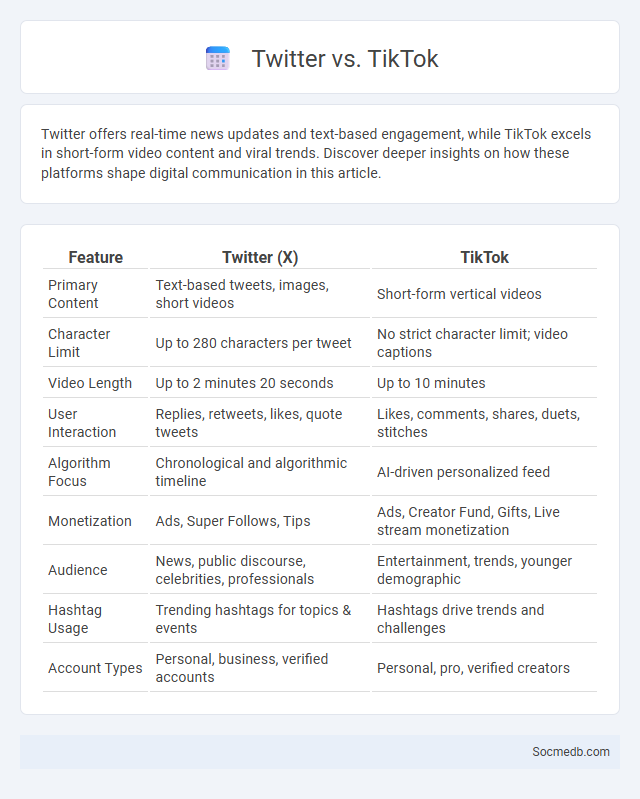
Photo illustration: Twitter vs TikTok
Twitter offers real-time news updates and text-based engagement, while TikTok excels in short-form video content and viral trends. Discover deeper insights on how these platforms shape digital communication in this article.
Table of Comparison
| Feature | Twitter (X) | TikTok |
|---|---|---|
| Primary Content | Text-based tweets, images, short videos | Short-form vertical videos |
| Character Limit | Up to 280 characters per tweet | No strict character limit; video captions |
| Video Length | Up to 2 minutes 20 seconds | Up to 10 minutes |
| User Interaction | Replies, retweets, likes, quote tweets | Likes, comments, shares, duets, stitches |
| Algorithm Focus | Chronological and algorithmic timeline | AI-driven personalized feed |
| Monetization | Ads, Super Follows, Tips | Ads, Creator Fund, Gifts, Live stream monetization |
| Audience | News, public discourse, celebrities, professionals | Entertainment, trends, younger demographic |
| Hashtag Usage | Trending hashtags for topics & events | Hashtags drive trends and challenges |
| Account Types | Personal, business, verified accounts | Personal, pro, verified creators |
Overview: Twitter vs TikTok vs Trending Topics
Twitter offers real-time updates and concise communication, making it ideal for tracking trending topics through hashtags and breaking news. TikTok emphasizes short-form video content with algorithm-driven trends, engaging younger audiences via viral challenges and creative expression. Your social media strategy should consider Twitter's strength in timely information and TikTok's dynamic content to effectively capture and analyze popular trends.
Social Media Popularity and User Base
Social media platforms such as Facebook, Instagram, and TikTok dominate global user bases with billions of active monthly users, reflecting their widespread popularity. Instagram boasts over 2 billion active users engaging daily, while TikTok's rapid growth surpassed 1 billion monthly users, signaling shifting trends toward short-form video content. Facebook remains the largest with approximately 3 billion monthly active users, consolidating its position as the leading platform for social interaction and digital marketing influence.
Content Formats and Engagement Styles
Social media platforms offer diverse content formats including videos, stories, reels, carousels, and live streams that cater to various audience preferences and enhance user interaction. Engagement styles such as comments, likes, shares, polls, and direct messages enable You to build a dynamic community and foster meaningful conversations. Choosing the right combination of content format and engagement style significantly boosts visibility and strengthens your online presence.
How Trends Emerge on Twitter
Trends on Twitter emerge through rapid user engagement with specific hashtags, keywords, or topics that gain widespread attention within a short period. Algorithms detect sudden spikes in mentions and interactions, amplifying content to a broader audience by promoting it on trend lists. Your participation in sharing or commenting can accelerate this process, helping shape which topics dominate the conversation.
Viral Mechanisms on TikTok
TikTok's viral mechanisms rely heavily on its For You Page algorithm, which analyzes user interactions, video information, and device settings to curate personalized content streams that accelerate engagement. Short-form video formats paired with trending sounds and challenges amplify shareability and viewer retention, making content more likely to go viral. User-generated duets, stitches, and algorithm-driven hashtag trends create dynamic opportunities for content amplification and network effects.
Identifying and Analyzing Trending Topics
Identifying and analyzing trending topics on social media involves monitoring platform-specific algorithms and user engagement metrics such as likes, shares, comments, and hashtag usage. Utilizing tools like Twitter Trends, Google Trends, and social listening software enables real-time data collection and sentiment analysis to detect emerging themes and viral content. This strategic approach allows brands and marketers to capitalize on current interests, optimize content relevance, and enhance audience connection.
Influence of Algorithms on Virality
Social media algorithms prioritize content based on user engagement metrics such as likes, shares, and comments, significantly amplifying the visibility of viral posts. These algorithms analyze user behavior patterns to promote personalized content, thereby accelerating the spread of trending topics across networks. The resulting feedback loop between algorithm-driven recommendations and user interactions plays a crucial role in shaping the virality and longevity of digital content.
Brand Strategies Across Platforms
Effective brand strategies across social media platforms involve tailoring content to the unique audience and features of each channel, such as visual-heavy posts on Instagram and professional insights on LinkedIn. Leveraging data analytics helps brands identify peak engagement times, optimize ad targeting, and refine messaging to enhance brand recognition and loyalty. Consistent brand voice combined with platform-specific customization maximizes reach and fosters community growth.
User Demographics and Behavior Patterns
Social media platforms exhibit distinct user demographics, with younger audiences predominantly engaging on TikTok and Instagram, while Facebook and LinkedIn attract older age groups and professionals, respectively. User behavior patterns reveal peak activity during evenings, high engagement with visual content such as videos and images, and a growing preference for ephemeral stories and live streaming formats. Data analytics show that users spend an average of 2.5 hours per day on social media, with mobile devices accounting for nearly 90% of access.
Future Trends in Social Media Competition
Future trends in social media competition emphasize the rise of AI-driven content personalization, enhancing user engagement by tailoring feeds to individual preferences with unprecedented accuracy. Platforms increasingly invest in augmented reality (AR) and virtual reality (VR) technologies to create immersive experiences that differentiate them in a crowded market. Your brand's success depends on leveraging these innovations to stay ahead in the evolving digital landscape.
 socmedb.com
socmedb.com